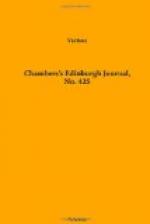The churches of Venice are numerous—about a hundred in all, being one for every thousand souls, while I am told there is a priest for every hundred. We visited eight or ten of the most remarkable; and so bewildering was their magnificence, and so confounding the multitude of fine things shewn in them, that if I had not taken note of everything at the moment, I must have had only one confused idea of something supra-mundanely fine. A great church in Venice is usually a structure of pure marble, with a dome or tower. The interior is one open space, with the usual double colonnade, a railed off altar-space at the upper end, and little chapels in the aisles on both sides. Generally, over the principal altar is some large scriptural picture—a Crucifixion, or a Taking Down from the Cross, or an Ascension; the production of Titian, or Tintoretto, or Paul Veronese, or some other artist of the Venetian school. Over the lateral altars are similar works of art. Sometimes one of these side-chapels is at the same time the tomb of a noble family, which assumes the duty of keeping it in order. In many of the churches, nothing can exceed the beauty of the sculpture which is lavished over the interior; and, while many features are common, each usually contrives to have some special beauty or some exclusive possession on which a peculiar fame rests. For example, the church of San Georgia Maggiore has some wooden carved-work by a Belgian artist, of surprising beauty. Gli Scalzi is a paragon of elaborate decoration. The church of the Frari, old and Gothic, is full of grand tombs, including those of several doges, that of Titian, and a monument to Canova. The Santa Maria della Salute has a fine collection of pictures over and above those in the church. This church was built in 1632, by a decree of the Senate, as an act of thanksgiving to the Virgin for putting an end to a pestilence by which 60,000 people had been carried off. It is a most beautiful structure, full of fine things; and altogether a curious monument of that delusion of ignorance and misdirected piety which made men assign to a chapter of priests the duty now committed to a Board of Health, and persuaded them that a church was of much greater efficacy for the cure of the pestilence than an hospital.
I have as yet said scarcely anything of the ducal palace and church of San Marco, which are the principal and central objects of Venice. The first is a quadrangular building, with a court in the centre; very peculiar antique architecture, with a double row of arcades both outside and in; the whole having a strikingly Oriental character. In front, and at one side, is a pavement, forming the principal open space in Venice; the haunt, of course, of many loungers of all characters; and distinguished by the two well-known pillars, one of which bears the lion of St Mark. The interior of the palace presents a succession of grand old halls, the scene of the court-glories of




